Vultures have quite the reputation as “gross scavengers who feed on carrion,” but like every animal, they have way more to them than that! There are seven species of vulture in the New World (North and South America), and they each have their own ecological niche that they’ve adapted to. The different species all share some similar characteristics, but let’s take a closer look at each of them. We are going to cover their habitat, physical characteristics, diets, and maybe an interesting fact or two. Let’s look and learn: what are the seven New World vulture species?
Black vulture
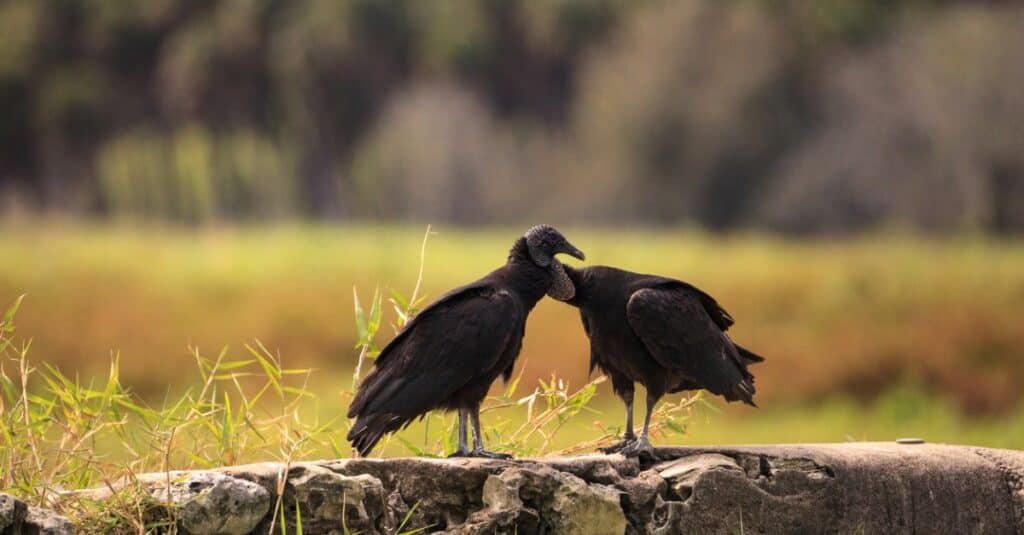
Black vultures are common carrion feeders with a wingspan of 5 feet.
©iStock.com/LagunaticPhoto
The black vulture is aptly named. With dark black and grey speckled feathers with a bald black head, this bird looks like an avian version of a Grim Reaper. In some ways, it serves that purpose as a carrion eater. It has white feathers resembling stars under the wings, helping to identify it from the air.
Their wingspan can get up to 5 feet wide, and they often find thermals to fly in since they can be heavy in compared to their wingspan. They can be seen flying as far north as the coasts of New York and as far south as Chile in South America. Additionally, they are in a period of expansion of their territory, pushing further and further north each year. Black vultures prefer open areas and often roost in secluded woods and roosts.
Like many vultures, black vultures feed on carrion (dead animals). They locate carcasses through smell and sight (whereas many Old World vultures only use sight). When feeding, they often congregate in large groups and can clear a carcass rather quickly. Generally, black vultures prefer dead material that is freshly dead (1-3 days). Like most other vultures, they have special bacterial colonies in their digestive system that allows them to eat rotting meat.
Turkey vulture
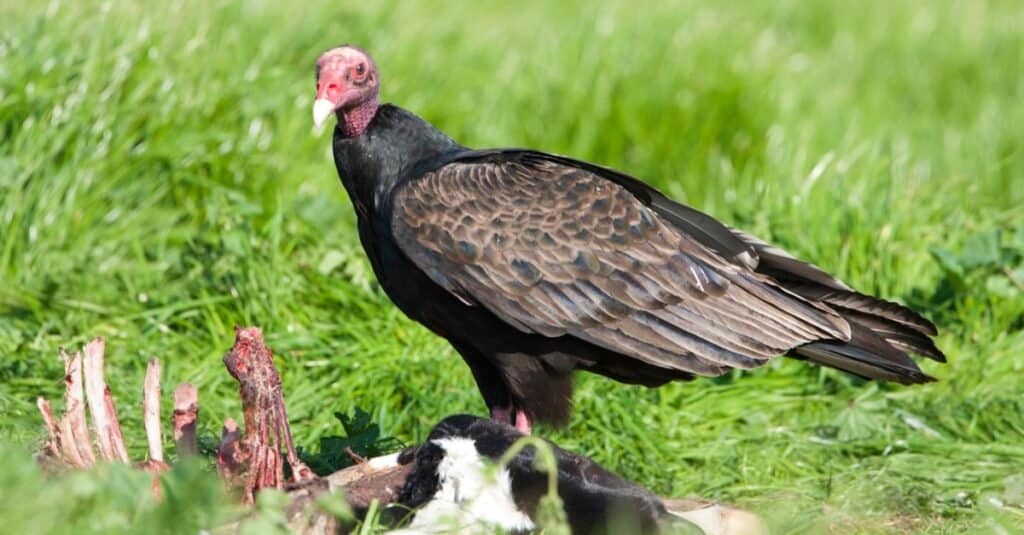
Turkey vultures can vomit their food when threatened by a predator, shooting it 10 feet!
©Agami Photo Agency/Shutterstock.com
Turkey vultures are large birds with dark brown feathers, gray wing bottoms, and bright red heads. Their name comes from their head color, which resembles that of a turkey. When seen up close, they resemble turkeys in a few ways but are distinctly different birds, only weighing 3 lbs and standing 2.5 feet tall.
With a wingspan of 6 feet, these large birds can be seen soaring high above, looking and smelling for dead material to eat. They live as far north as southern Canada, with their territory stretching as far south as the southern United States, especially when they migrate in the winter. They generally prefer open country and large secluded areas to roost. They can most often be seen in the morning on sunny days but also congregate on light poles and other manmade structures.
Turkey vultures eat carrion like most other vultures. In fact, they exclusively eat carrion since their talons are dull and useless for killing. Their featherless heads are used to reach into carcasses and tear the meat off without getting detritus stuck on their heads.
Lesser yellow-headed vulture
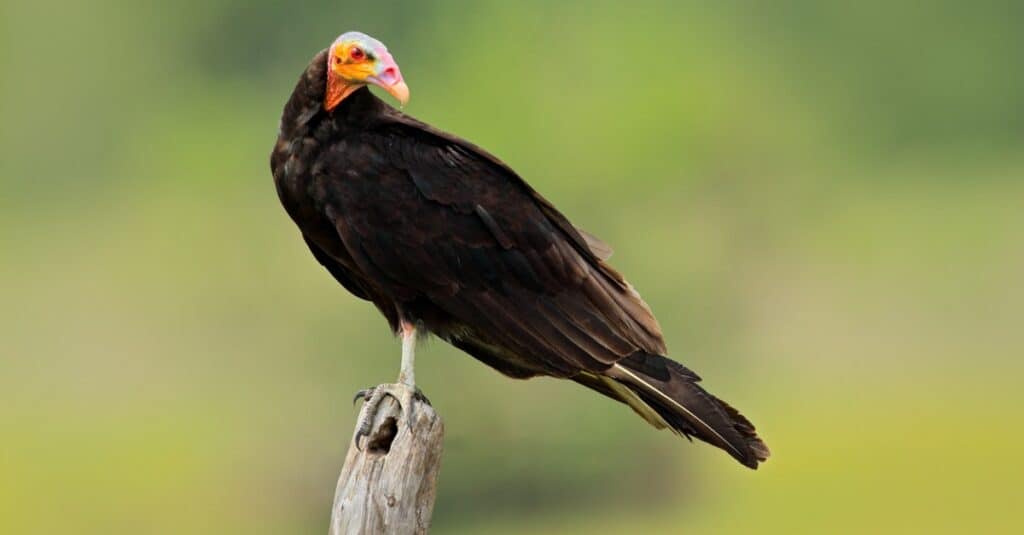
Lesser yellow-headed vultures are the smallest New World vulture.
©iStock.com/Ondrej Prosicky
The lesser yellow-headed vulture is the smallest of all the New World vultures. They have black feathers (most of which have a light green sheen) and a yellow head. Their bare head has a reddish forehead and blue splotches around the top and sides, but one of their most striking features is their red eyes.
They are the smallest of the New World vultures, with a wingspan that generally doesn’t reach past 5 and a half feet. They are about two feet tall and only weigh up to 3.5 lbs at their heaviest. They live as far north as the Yucatan Peninsula in Mexico and as far south as the southern tip of Brazil. Their preferred habitat is lowland grasslands and swamps or degraded forests. Their habitat preference gives them their nickname, the savannah vulture.
They eat carrion like other vultures, but the lesser yellow-headed culture relies on the larger king vulture when it comes to larger carcasses. Since the lesser yellow-headed vulture is smaller, it can’t tear open the hides of larger animals and requires the larger vulture to help.
Greater yellow-headed vulture

Greater-yellow headed vultures can have a wingspan of up to 6 feet.
©iStock.com/neil bowman
The greater yellow-headed vulture was officially split from the lesser-yellow-headed vulture as a species in 1964 and has many of the same characteristics. It has black plumage across its entire body and has a yellow to pale orange head and neck.
It’s a bit bigger than its “lesser” cousin, with a wingspan that can reach 6 feet wide. It stands at 2-3 feet tall and generally weighs 3.6 lbs. They live from northern South America, all the way to the top of Uraguay. The common name for the greater yellow-headed vulture is the forest vulture, a name that shows its preferred habitat. Forest vultures generally stick to lowland forests and tropical regions, nesting in trees and similar structures.
Forest vultures eat carrion, like most other vultures. Roadkill and dead carcasses are common food sources and are sought out through sight and smell. They have microbial systems in their stomachs that allow them to eat decaying meat, helping keep the ecosystem free from disease.
California condor
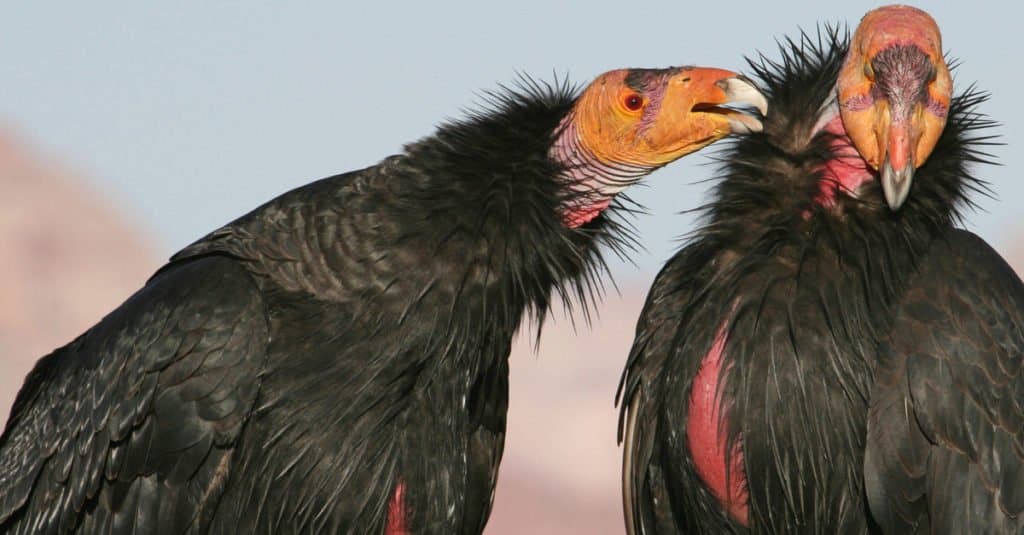
The California condor are the largest terrestrial birds in North America.
©MTKhaled mahmud/Shutterstock.com
The California condor is the second largest vulture in the world by wingspan. They have black plumage with a bald yellow head. On the underside of their wings, white patches are visible as they soar high above. They were nearly extinct in 1987, but a few were captured, bred, and re-released into the wild. Still, they are critically endangered to this very day.
California condors are the largest terrestrial birds in North America. With a wingspan of 9.5 feet, they dwarf a man when outstretched. Their wings are 2 feet longer than the next closest competitor, the golden eagle. They can weigh up to 26 lbs, dwarfing most of the other birds on the list. Interestingly, they are also some of the longest-lived birds around, easily living into their 60s. They are present through reintroduction in Arizona, Utah, southern California, and Baja Mexico.
California condors are carrion feeders, originally feeding off of the megafauna that lived in the region (but are now extinct). They search exclusively by sight since they have no sense of smell. They are large enough to scare most other animals away from a carcass, with the exclusion of a bear or golden eagle. They can eat up to 3.5 lbs of meat in one sitting.
Andean condor

The Andean condor is the largest bird of prey in the world.
©Cezary Wojtkowski/Shutterstock.com
The Andean condor is the other giant on our list. It is black with a ruff of white around the neck. Its head and neck are featherless but have a dull red color as well as a wattle (a comb) around the neck. They are endangered, but captive breeding programs currently exist to help sustain populations.
These massive birds are considered one of the highest flying birds in the world. Their wingspan regularly reaches over 10.5 feet, and they weigh up to 33 lbs. They are often considered the largest bird of prey in the world. They live along the Andean mountain range (hence their name) and are high-altitude birds that stretch as far north as Columbia all the way to the southern tip of South America. They are among the longest-lived birds around, often living into their 70s.
The Andean condor is a carrion eater that searches for food over massive distances, sometimes up to 120 miles a day. They prefer large animal carcasses, preferring llamas, alpacas, and rheas. Unlike other vultures, Andean condors will occasionally hunt small prey like rodents and birds.
King vulture
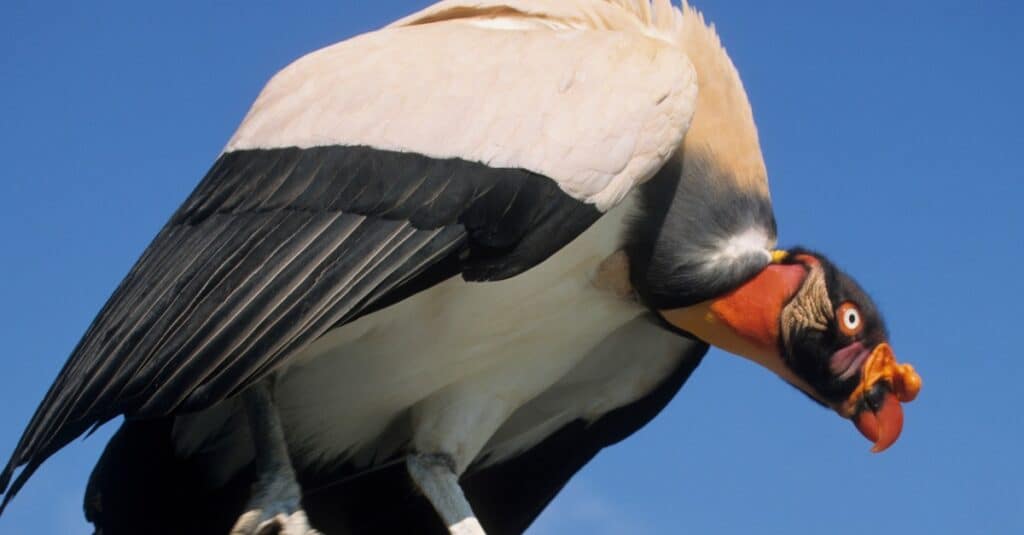
The king vulture has the strongest skull and sharpest beak of any New World vulture.
©iStock.com/Michel VIARD
The king vulture may be the prettiest of all the vultures on our list. King vultures have white feathers with a black-blue ruff around their neck. Their wings are tipped in black, with white lining the edges of the “fingers.” Their heads are bald, but their skin is alternating orange, red, blue, purple, and black. Their colors often earned them sports in the folklore of ancient Mayan stories.
Outside of the condors, king vultures are the largest vulture species in the New World. They have a wingspan that can reach 7 feet and can weigh up to 10 lbs. Additionally, their skull and bill are the strongest (relatively) of all New World species. They live between southern Mexico and northern Argentina, preferring tropical lowland forests. Occasionally they will visit and inhabit savannahs and grasslands, provided there are forests nearby.
The king vulture eats carrion, often things like beached fish and dead lizards. While there are some reports of king vultures killing small animals, they are infrequent and uncommon. There is currently some debate on how king vultures find their food, but some believe they simply follow other scavengers to food. This strategy works especially well since king vultures are often the only birds that can initially pierce the hides of larger animals. Once a king vulture opens up a carcass, other scavengers can eat.
The photo featured at the top of this post is © iStock.com/neil bowman
Thank you for reading! Have some feedback for us? Contact the AZ Animals editorial team.






